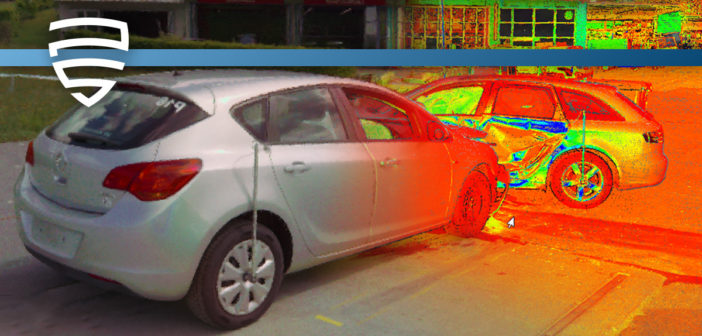What if it were possible to preserve forever a crime scene, a crash scene, a weapon or a witness view; a Forensic Digital Twin?
Forensic Investigators get one opportunity, one shot, one effort, in which to locate, identify, preserve, document and harvest all of the scene evidence, whether critical or inert. One. Just one. That’s why they need the Forensic Digital Twin.
Outside influences like for example the weather may deteriorate or improve — either way altering the prevailing scene environment. The rush hour, the school run, the wedding at a church nearby and other circumstances mean that investigators face pressure to reopen the location to avoid inconveniencing the public. Similarly, overtime or other accumulating costs, as well as tiredness and mental fatigue at the end of an already long shift, bring additional pressure to close the location. So amid this unique investigative theatre, where multiple pressures combine, the attending forensic expert has one ever-narrowing opportunity to capture everything. To capture what is important today. To capture what might be important tomorrow. To capture what might be important next week, or in a decade’s time when a review is conducted or fresh evidence emerges.
Forensic Digital Twin – a holistic 3D digital capture of scenes
What is needed then, is a full and complete, holistic capture of the scene, preserved for eternity in a digital format to be examined and re-examined — not only by the forensic experts at the scene, but also the defence expert, or the secondary niche forensic expert maybe, and of course the legal teams, the judge and the jury. Where appropriate, any person can be afforded a revisit to the scene within a digital environment. This is all entirely possible if the attending forensic expert is afforded the hardware, the software and the training to capture a Forensic Digital Twin of the scene.
Forensic Digital Twin: an accurately harvested 3D digital replica of a scene, evidence, an object, a location, an environment, or a view, obtained in the process of conducting a forensic investigation or reconstruction
As complete as possible, or proportionately necessary, the resultant Forensic Digital Twin is a digital model of a scene, location or artefact that is of interest to the investigation or the reconstruction of a public safety event. The Forensic Digital Twin may originate through a multitude of capture methods, from ground-level, pole-assisted or drone photogrammetry; single-shot EDM; GNSS with added onboard georeferenced imagery or multimillion points per second LiDar laser scanning; the tools for this process are numerous and the varying scales of accuracy should be respected and referenced within the Forensic Digital Twin modelling process.
Forensic Digital Twin – a snapshot in time
Unlike Digital Twins used in other industries, the Forensic Digital Twin is a snapshot in time, an evidential freeze-frame where the erosion, disturbance, removal or addition of both environment and perishable evidence is prevented; the Forensic Digital Twin Master Exhibit remains stable, and pure, as captured, indefinitely.
Where the Forensic Digital Twin does align with its engineering, construction and manufacturing counterparts, is that absolute copies of the Forensic Digital Twin Master Exhibit can be used to run simulations and animations to test theories and hypotheses with changing environmental factors and with the addition or subtraction of elements within the model; to extrapolate the factual evidential state of a scene to reliably indicate, within scientifically sound principles, the likely sequence of events, actions or inactions.
Forensic Digital Twin – a 3D digital scene replica created in advance
A Forensic Digital Twin can also be created in advance. A vulnerable location. A venue for a large high-security event. Given the recent rulings surrounding the need for venues and security providers to be more accountable for the safety of attendees, even to the risk of terrorist events, it is increasingly appropriate for venues to acquire an accurate, detailed and realistic Forensic Digital Twin of their facility. This model can be used for all aspects of Public Safety from designing camera placements and creating suitable overlap fields of views, to documenting emergency response documents for multiple critical incident types in full 3D.
A Forensic Digital Twin allows for interactive, venue-specific familiarisation, without the need to ever attend the locus. Immersive VR experiences enable security staffers to familiarise themselves with the venue in a passive and calm environment, train within a heightened defined scenario, or stress test the human response to catastrophic terrorist incidents. Because of the Forensic Digital Twin, this can be achieved from anywhere in the world. Points of view from within the model can be observed, considered and sensed by an individual or a group, who were not present at the scene, or indeed who may have never even visited the scene locus, or the country in which it is situated.
Forensic Digital Twin – a scene preserved forever
Should the unimaginable occur, the Forensic Digital Twin created as the training and planning model, can be modulated and refreshed with the new data captured in the immediate post-event investigation; significant time savings can be made from having the pre-incident model on file. Before and after models can be compared to identify all areas of change, highlighting evidence or damage, and potentially assisting in the calculation phase of any explosive type and magnitude for example.
The Forensic Digital Twin; a scene preserved.
Author: Marcus Rowe
Public Safety and Forensics Business Manager
UK, Ireland and Benelux, Leica Geosystems














